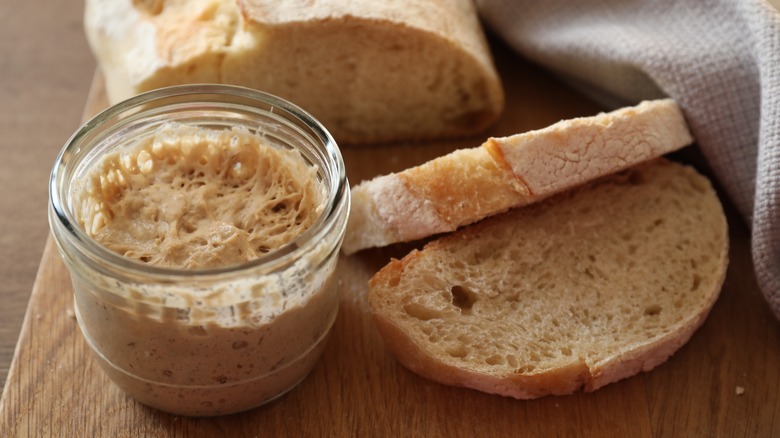The Key To Feeding A Sourdough Starter
If you are a proud DIYer and aren't already keeping a sourdough starter on hand, there's never a better time to start than now. Some folks find the task intimidating, particularly how to feed it. The process is actually quite uncomplicated, yet it never hurts to have the details explained by a professional.
Nicole Bean is the owner and operator of two pizzeria locations in Houston — which along with the Midwest, is another overlooked region for unique pizza – called Pizaro's Pizza Napoletana. As a pizza and bread-making expert, she is an authority when it comes to homemade bread. She explained that one of the chief concerns regarding sourdough starter is consistently nourishing it. She said, "Feeding should be done frequently and on a schedule to maintain it."
Diligence is necessary because a sourdough starter needs perpetual sustenance to survive. On average, it should be fed every day around the same time. This gives microorganisms more carbs like fructan to consume, continuing fermentation. Because the lactic acid-producing bacteria feasts on some of the gluten, even some people with gluten sensitivities can enjoy sourdough bread.
How to feed it is easy, as it only requires two ingredients. Bean says, "Usually you would remove a bit of it and feed with fresh water and flour to 'replenish.'" Discarding or using some of the starter gives it enough room in the container to rise as it consumes sugar from the flour – bread flour is a good option here — and becomes a leavening agent for an airy, tangy loaf of sourdough.
Once you know how to feed the starter, monitor it
Many who aren't experienced in feeding a sourdough starter aren't sure what to look for to know it's coming along. Bean has an answer for this as well. "You'll know when it's ready to use as you'll often see tiny bubbles forming in the starter," she said. "This means proper fermentation is happening; the more bubbles and the smaller, the better!"
You can use any food-grade container to store your mixture, but some come with advantages others don't. According to Bean, "I always recommend using a clear glass jar for starters so that you can see what's happening inside the jar." This allows you to discern whether the mix is doing what it should and adjust your feeding process if necessary.
One thing that can kill it is a hot environment. According to Bean, "Starters like and thrive in 70-75 degrees, so if your kitchen gets hot then your starter will ferment faster — killing it faster." The climate of your kitchen is generally easy to control, but there are some hot spots you will want to watch out for. For instance, the top of your fridge will be relatively warm. If the ambient temperature of your kitchen is typically in the 70 to 75 degrees Fahrenheit range, the counter is an excellent location for your sourdough starter. Plus, with it out in the open, you'll walk by it throughout the day and be less likely to forget a feeding.

